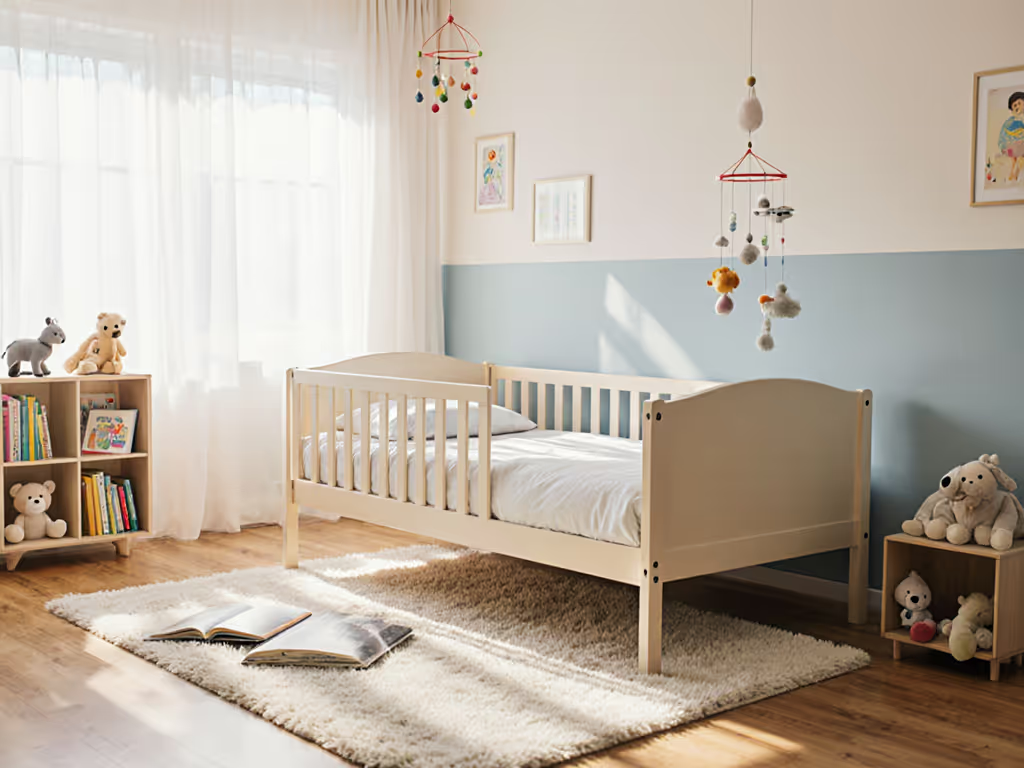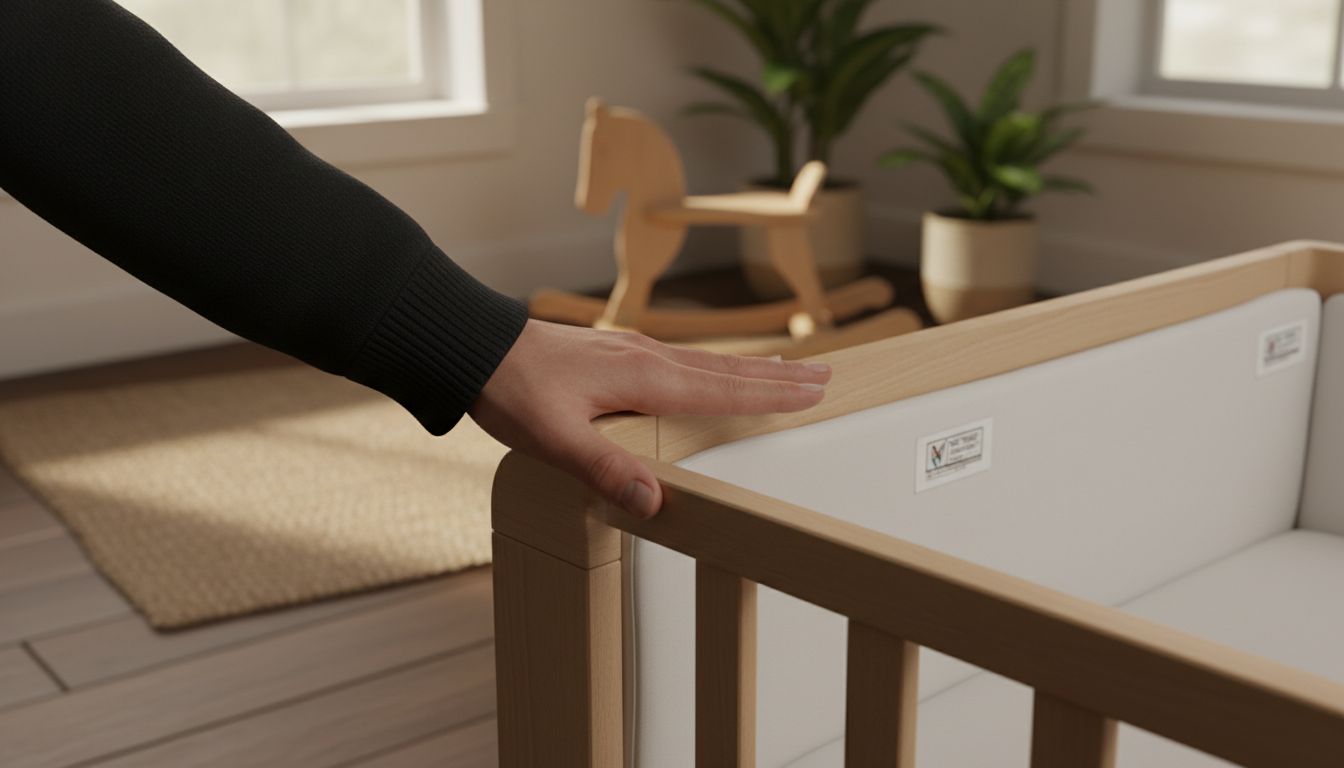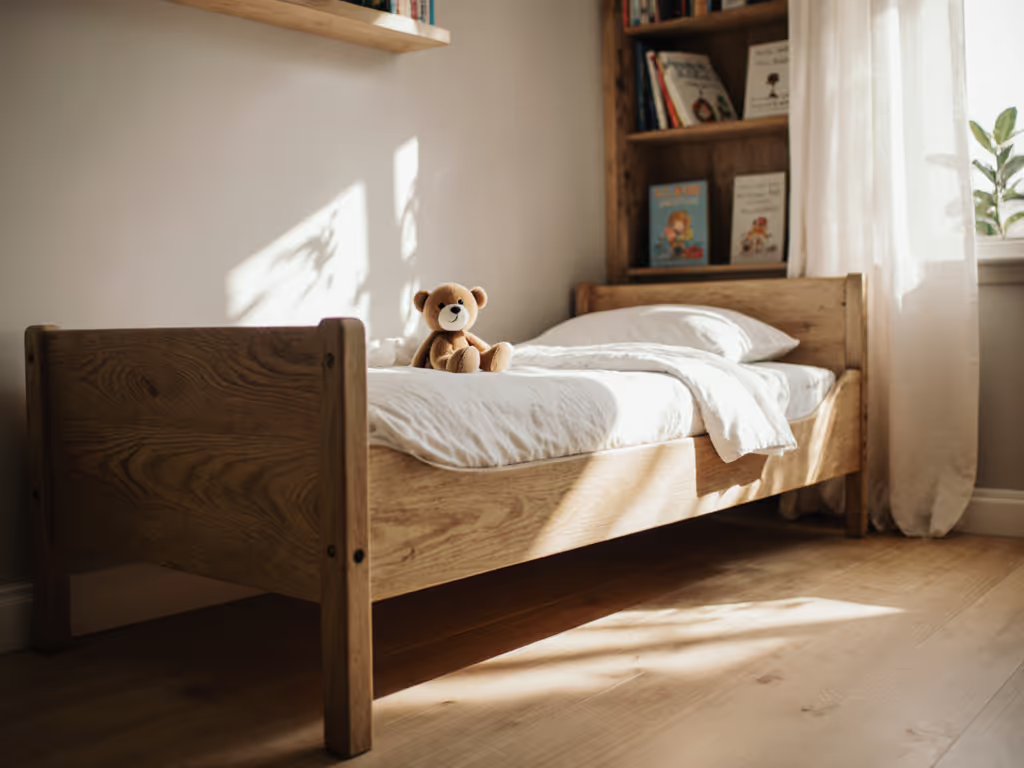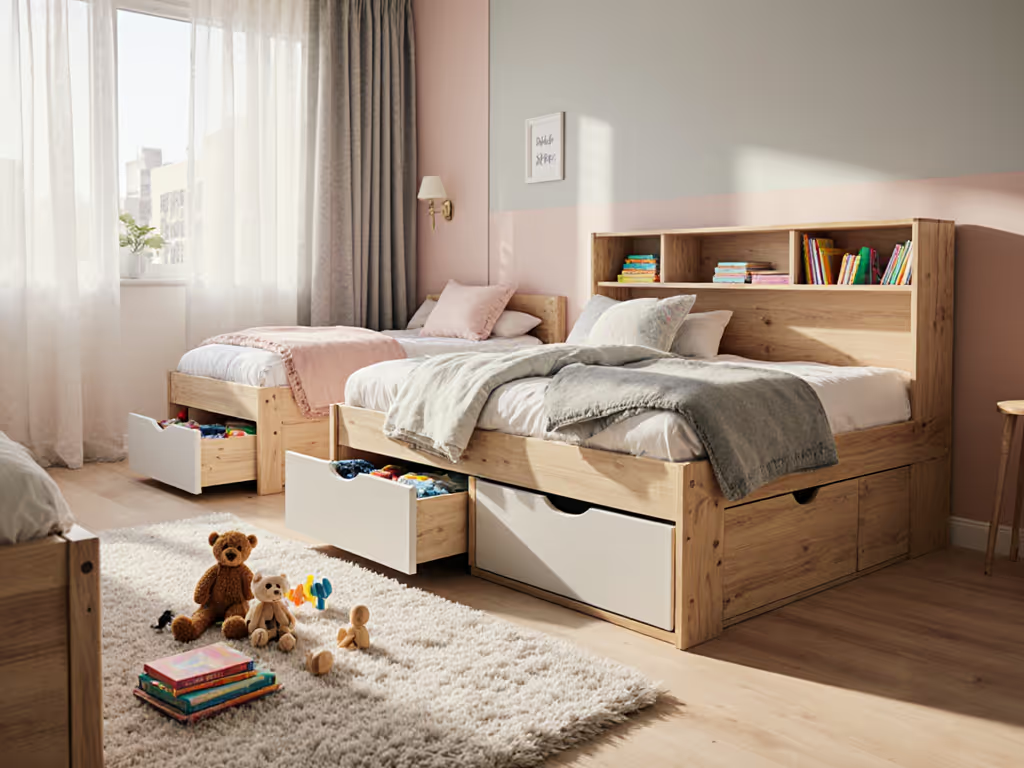
What Is Convertible Toddler Bed? Complete Overview

Did you know that children spend up to 40 percent of their early years sleeping? Choosing the right bed goes beyond comfort. It shapes bedtime routines, home organization, and your long-term budget. With so many options—from classic crib conversions to imaginative themed designs—parents are looking for sleep solutions that combine safety, flexibility, and style. Discover how convertible toddler beds address common concerns while adapting seamlessly to both your child’s needs and your living space.
Key Takeaways
| Point | Details |
|---|---|
| Versatility of Convertible Toddler Beds | These beds adapt from crib to toddler and potentially to full-sized bed, reducing the need for multiple purchases as children grow. |
| Safety Priorities | Modern toddler beds feature essential safety components such as sturdy side rails and low profiles to prevent falls. |
| Economic Advantage | Investing in convertible beds results in long-term savings by eliminating frequent replacements and offering extended usability of 3-5 years. |
| Space Efficiency | Many designs incorporate storage solutions and modular configurations, optimizing living space for families in compact environments. |
Defining Convertible Toddler Beds and Misconceptions
A convertible toddler bed represents a smart, adaptable sleep solution designed specifically for young children transitioning from infancy to early childhood. Unlike traditional cribs or standard beds, these innovative sleeping spaces are engineered to grow alongside your child, offering remarkable flexibility and long-term value. These beds typically adjust from an infant sleeping configuration to a toddler-sized bed, and sometimes even expand to accommodate older children.
The core concept behind convertible toddler beds is versatility. Parents can seamlessly transform the bed as their child develops, eliminating the need for multiple bed purchases during critical growth stages. Most convertible models feature adjustable side rails, removable components, and modular designs that can adapt to different room configurations and safety requirements. Key transformative features often include:
- Convertibility from crib to toddler bed
- Optional side rail removal
- Potential expansion to full-sized bed
- Adjustable mattress height settings
Common misconceptions about convertible toddler beds often stem from misunderstandings about their functionality and value. Many parents assume these beds are unnecessarily complicated or significantly more expensive than traditional options. However, when considering the long-term investment, convertible beds actually provide substantial economic benefits. By eliminating the need to purchase multiple beds as your child grows, these versatile sleep solutions offer remarkable cost-effectiveness and practicality for budget-conscious families.
Types and Design Variations Explained
Toddler bed designs have evolved dramatically, offering parents a wide array of innovative sleeping solutions tailored to different spatial constraints, aesthetic preferences, and developmental needs. From classic rectangular frames to creative architectural inspirations, modern toddler beds are far more than simple sleeping platforms. The market now presents an exciting range of designs that blend functionality, safety, and imaginative appeal.
The most prevalent design categories include:
- Classic Toddler Beds: Traditional rectangular frames with low side rails, typically sized between cribs and twin beds
- Montessori Floor Beds: Low-profile designs promoting independence and easy child access
- House Frame Beds: Whimsical structures resembling miniature houses, offering a playful sleeping environment
- Themed Beds: Character or adventure-inspired designs featuring unique shapes and decorative elements
- Convertible Beds: Adaptable models that transform from infant cribs to toddler beds and potentially full-sized beds
Space considerations play a crucial role in bed selection. Urban parents with compact living spaces might gravitate towards multi-functional designs like loft-style beds with built-in storage or platform beds with minimal footprints. These intelligent configurations maximize room efficiency while providing a dedicated, safe sleeping area for growing children. Each design variation addresses specific parental needs, whether it's maximizing bedroom space, encouraging child independence, or simply making bedtime a more engaging experience.
Key Features: Safety, Durability, and Materials
When selecting a toddler bed, safety features are the absolute top priority for parents navigating their child's critical developmental transition. Modern toddler beds are meticulously engineered with multiple protective elements designed to prevent falls, minimize injury risks, and create a secure sleeping environment. The Consumer Product Safety Commission (CPSC) establishes stringent guidelines that manufacturers must follow, ensuring beds incorporate low-profile designs, robust side rails, and rounded edges that eliminate potential hazard points.
The core safety and durability components typically include:
- Rounded Corner Design: Minimizes potential injury risks
- Sturdy Side Rails: Prevent accidental rolling or falling
- Low Height Configuration: Allows easy child entry and exit
- Non-Toxic Material Selections: Ensure chemical-free sleeping surfaces
- Reinforced Frame Construction: Provides long-lasting structural integrity
Material selection plays a crucial role in both safety and longevity. High-quality toddler beds are predominantly crafted from sustainable hardwoods like maple or birch, engineered woods with non-toxic finishes, or advanced composite materials that resist wear, moisture, and potential structural degradation. Parents should prioritize beds with certified non-toxic paint and finishes, ensuring zero harmful chemical exposure. The ideal toddler bed balances robust construction with lightweight design, allowing for easy room reconfiguration while maintaining exceptional durability through multiple years of active childhood use.

Transitioning From Crib to Toddler Bed
The journey from crib to toddler bed marks a significant milestone in a child's development, representing both an exciting and potentially challenging transition for parents. Most children typically make this switch between 18 months and 3 years old, with individual readiness varying based on physical growth, emotional maturity, and safety considerations. The American Academy of Pediatrics recommends watching for specific signs of transition readiness, such as attempting to climb out of the crib, demonstrating increased independence, or showing curiosity about larger sleeping environments.
Key indicators that your child might be ready for a toddler bed include:
- Consistently climbing out of the crib
- Height exceeding 35 inches
- Expressing desire for a "big kid" bed
- Demonstrating ability to follow basic safety instructions
- Showing emotional preparedness for change
Preparing for this transition requires careful planning and a patient approach. Parents should create a supportive environment by involving their child in bed selection, maintaining consistent bedtime routines, and implementing gradual changes. Safety precautions are paramount during this period. Experts recommend placing a soft rug beside the new bed, installing safety gates to prevent nighttime wandering, and creating a bedroom setup that minimizes potential hazards. The goal is to make the transition feel like an exciting adventure rather than a disruptive change, helping your child feel secure and empowered in their new sleeping space.
Costs, Lifespan, and Space-Saving Benefits
The financial landscape of toddler bed investments extends far beyond initial purchase price, representing a strategic long-term decision for growing families. Convertible toddler beds emerge as a particularly smart economic choice, offering remarkable adaptability that can potentially save parents hundreds of dollars over several years. By designing beds that transform across multiple growth stages—from infant crib to toddler bed to potentially full-sized bed—manufacturers have created solutions that dramatically reduce furniture replacement costs.
Economic benefits of convertible toddler beds include:
- Elimination of multiple furniture purchases
- Extended usability across 3-5 years of child's growth
- Integrated storage reducing need for additional furniture
- Potential resale value due to adaptable design
- Lower long-term replacement expenses
Space optimization represents another critical advantage, especially for urban families or those living in compact housing environments. Modern space-saving bed designs incorporate intelligent features like built-in drawers, under-bed storage compartments, and modular configurations that maximize limited square footage. These innovative approaches transform a single piece of furniture from a simple sleeping surface into a multifunctional living solution. By consolidating sleeping space with storage and design efficiency, convertible toddler beds offer parents an elegant resolution to the perpetual challenge of managing children's rapidly evolving needs within constrained living spaces.
Comparing Convertible Beds to Standard Alternatives
When evaluating toddler sleeping solutions, parents face a critical decision between convertible beds and standard alternatives, each offering unique advantages and limitations. Convertible beds distinguish themselves through remarkable adaptability, designed to seamlessly transition across multiple growth stages—from infant crib to toddler bed and potentially to a full-sized bed. This evolutionary approach contrasts sharply with traditional toddler beds, which typically serve a much shorter functional lifespan and require complete replacement as children grow.
Here's how convertible toddler beds compare to standard toddler beds:
| Feature | Convertible Toddler Bed | Standard Toddler Bed |
|---|---|---|
| Lifespan | 3-5 years | 1-2 years |
| Upfront Cost | Higher | Lower |
| Flexibility | Multiple configurations | Single-use design |
| Space Utilization | Built-in storage<br>Modular setups | Basic frame only |
| Resale Value | Higher secondary market value | Limited resale potential |
| Replacement Need | Rare, adapts to growth | Frequent, as child grows |
Key comparative differences include:
- Longevity: Convertible beds last 3-5 years, standard beds 1-2 years
- Cost-Effectiveness: Higher upfront investment for convertible beds
- Flexibility: Multiple configuration options versus single-use design
- Space Utilization: Integrated storage in convertible models
- Resale Potential: Convertible beds maintain higher secondary market value
Standard toddler beds often represent a more budget-friendly initial investment, appealing to parents seeking immediate affordability. However, they ultimately prove less economical due to frequent replacements. Convertible beds, while demanding a higher initial expenditure, provide a strategic long-term solution that adapts to a child's changing needs. The ability to transform between configurations not only saves money but also offers a sense of continuity, allowing children to maintain a familiar sleeping environment throughout their early developmental stages.
Ready to Choose the Perfect Convertible Toddler Bed for Your Child
Transitioning your little one from crib to toddler bed is a big step filled with questions about safety, durability, and space. The article highlights how convertible toddler beds offer the flexibility to grow with your child while maximizing room space and providing peace of mind with built-in safety features. If you are facing challenges like finding a bed that adapts to your child's changing needs or making a smart long-term investment, you are not alone.
At City Toddler Beds, we understand these worries and goals deeply. Our expert guides and carefully curated content focus on helping parents like you select beds that combine practical design, safe materials, and space-saving benefits. Explore insights on making the crib to toddler bed transition and learn how to choose a bed that protects your child while fitting your home. Don't wait to create a secure, comfortable sleep space that supports your family for years to come. Visit City Toddler Beds now to get started on this important journey.
Frequently Asked Questions
What is a convertible toddler bed?
A convertible toddler bed is a versatile sleeping solution designed for young children, allowing it to adapt from an infant crib to a toddler bed, and potentially even to a full-sized bed, as the child grows.
What are the key features of convertible toddler beds?
Key features include convertibility from crib to toddler bed, optional side rail removal, adjustable mattress height settings, and in some models, the ability to expand into a full-sized bed.
How do I know when my child is ready to transition to a toddler bed?
Signs of readiness include consistently climbing out of the crib, exceeding a height of 35 inches, expressing interest in a "big kid" bed, and showing emotional preparedness for change.
What are the advantages of convertible toddler beds compared to standard toddler beds?
Convertible toddler beds typically last longer (3-5 years), offer multiple configurations, include space-saving features like built-in storage, and maintain higher resale value, making them a cost-effective long-term investment compared to standard toddler beds, which usually have a shorter lifespan (1-2 years).




